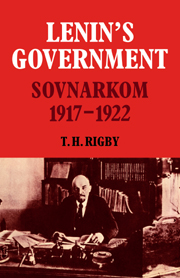Book contents
- Frontmatter
- Contents
- Tables
- Preface
- Acknowledgements
- Abbreviations
- Part One SMOLNY: SOVNARKOM TAKES SHAPE
- Part Two THE KREMLIN: SOVNARKOM IN ACTION
- Part Three OF MEN AND INSTITUTIONS
- 9 The system and the chief
- 10 The people's commissars: recruitment
- 11 The people's commissars: personal background
- 12 Government, soviets and party
- 13 Props for an ailing chairman
- 14 The last months
- 15 Some historical reflections
- Appendix A
- Appendix B
- Notes
- Bibliography
- Index
- Plate section
9 - The system and the chief
Published online by Cambridge University Press: 05 November 2011
- Frontmatter
- Contents
- Tables
- Preface
- Acknowledgements
- Abbreviations
- Part One SMOLNY: SOVNARKOM TAKES SHAPE
- Part Two THE KREMLIN: SOVNARKOM IN ACTION
- Part Three OF MEN AND INSTITUTIONS
- 9 The system and the chief
- 10 The people's commissars: recruitment
- 11 The people's commissars: personal background
- 12 Government, soviets and party
- 13 Props for an ailing chairman
- 14 The last months
- 15 Some historical reflections
- Appendix A
- Appendix B
- Notes
- Bibliography
- Index
- Plate section
Summary
We now have some idea of how the Sovnarkom and its two inner bodies emerged and developed in the years of revolution and civil war, how each operated and how they related to each other and to the administrative machine of the nascent Soviet state. In view of the constant flux and confusion and the dominating influence of Lenin's mind and will, the casual observer might be forgiven for seeing in the early Sovnarkom little more than the loosely-organised following of a triumphant charismatic leader. As the reader who has followed our analysis to this point will realise, however, this would be a profoundly misleading impression. From the very first weeks of its existence, Sovnarkom displayed an impulse towards articulation of its structures and regularisation and routinisation of its procedures: in other words towards institutionalisation. By the end of the Civil War it had evolved into a set of distinct but interlocking bodies operating closely together as a system, albeit a far from perfect one.
In 1921, despite the daunting problems of social disorder and economic collapse confronting the regime, the Sovnarkom system was for the first time able to function free of the overwhelming demands of daily military necessity. This, moreover, was the last year in which Lenin stood at its controls, although formally he remained chairman until his death in January 1924. Later we shall be considering the changes set in train by Lenin's illness, but let us now look more closely at how the system operated in 1921.
- Type
- Chapter
- Information
- Lenin's GovernmentSovnarkom 1917-1922, pp. 99 - 120Publisher: Cambridge University PressPrint publication year: 1979

